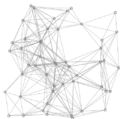Dijkstra's algorithm facts for kids
Dijkstra's algorithm is a clever way to find the shortest path between places in a network. Imagine you have a map with different towns and roads connecting them. Dijkstra's algorithm helps you figure out the quickest way to get from one town to all the other towns. It's super useful for things like GPS navigation! This algorithm works best when all the roads have a distance that is zero or more, meaning no "negative" distances.
Contents
What is Dijkstra's Algorithm?
Dijkstra's algorithm is a special algorithm that helps computers solve problems. It's like a step-by-step recipe for finding the shortest routes. It works on a "graph," which is just a fancy word for a network of points (called "nodes" or "vertices") connected by lines (called "edges"). Each edge has a "weight" or "distance" showing how far it is between two points.
How Does it Work?
The main idea behind Dijkstra's algorithm is to explore the network step by step. It always picks the closest unvisited place and updates the distances to its neighbors. It's a bit like a ripple spreading out from your starting point, always finding the shortest way to new places.
Step-by-Step Guide
Here's how Dijkstra's algorithm finds the shortest paths:
- Start your journey: Pick a starting place in your network. Give this starting place a "distance" of 0. All other places get a very large distance (like infinity) because you haven't figured out how to get there yet.
- Keep track of visited places: You'll need a list of places you've already visited and found the shortest path to.
- Repeat these steps until all places are visited:
- Find the closest unvisited place: Look at all the places you haven't visited yet. Choose the one that currently has the smallest distance number next to it.
- Mark it as visited: Once you pick a place, mark it as "visited." This means you've found the shortest way to reach it.
- Update distances for its neighbors: For every place directly connected to the one you just visited:
- Add the distance of the place you just visited to the distance of the connection between them. This gives you a new possible total distance to the neighbor.
- If this new total distance is smaller than the neighbor's current distance, update the neighbor's distance. Also, remember that you reached this neighbor from the place you just visited.
- All places visited: When every place in your network is marked "visited," you're done! You now know the shortest distance from your starting point to every other place.
Finding the Shortest Path
After the algorithm finishes, you can easily find the shortest path to any place.
- Start at your destination: Begin at the place you want to reach.
- Work backward: Look at which place helped you find the shortest distance to your current spot. Go to that place.
- Keep going: Repeat this process, moving backward from place to place, until you reach your starting point.
- The path is revealed: The connections you followed backward are the shortest path from your start to your destination!
Who Invented It?
Dijkstra's algorithm was created by a brilliant Dutch computer scientist named Edsger W. Dijkstra. He came up with it in 1956 and published it in 1959. He was thinking about how to make computers solve problems efficiently.
Where is it Used?
This algorithm is used in many important ways today:
- GPS Navigation: When your phone or car GPS tells you the fastest way to get somewhere, it's often using Dijkstra's algorithm.
- Network Routing: It helps internet routers find the quickest way to send data packets across the web.
- Logistics: Companies use it to plan the most efficient delivery routes for trucks and packages.
- Gaming: In video games, it can help characters find the shortest path through a maze or across a map.
Images for kids
See also
 In Spanish: Algoritmo de Dijkstra para niños
In Spanish: Algoritmo de Dijkstra para niños 
- Algorithm
- Graph theory
- Shortest path problem



